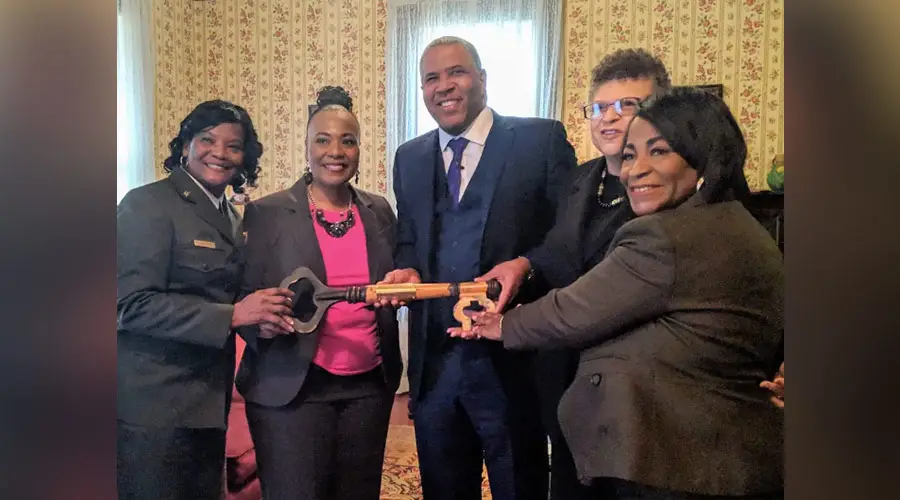National Park Foundation Works To Preserve Landmarks
Entrepreneur, investor and philanthropist Robert F. Smith is an avid supporter of the National Park Service and the National Park Foundation’s cultural preservation efforts, particularly sites associated with Black history and culture. Ahead is an article that was published in the USA Today 2024 National Parks Edition regarding some of Smith’s efforts. Particularly, it examines what Fund II Foundation, of which Smith is the founding director and President, is doing to protect and maintain these storied locations in the U.S., including the King family homes and the Emmett Till and Mamie Till-Mobley National Monument.
Robert F. Smith was a baby in his mother’s arms, surely being jostled by the crowd and a bit overwhelmed by the noise, but he was still there for a pivotal moment in American history. It was August 28, 1963, and Smith’s mother had taken her two sons to the nation’s capital for the March on Washington for Jobs and Freedom and to hear Dr. Martin Luther King Jr. speak. They were among the 250,000 people who had gathered to pressure Congress to pass civil rights legislation.
Fast-forward 60 years, and not only did Smith speak at the 2023 anniversary of the march, but the foundation he created, Fund II Foundation, was pivotal in the National Park Service’s acquisition and restoration of Dr. King’s homes in Atlanta, where the Martin Luther King Jr. National Historical Park gained its current designation in 2018.
“The homes in which Martin Luther King was born and where he raised his family have a special place in my heart,” Smith says. “I believe in the power of storytelling, and people who witnessed Dr. King speak, including my family, continued to tell stories about his speech and its impact for many years.”
For many Americans, the country’s national parks evoke magnificent landscapes, abundant wildlife and an opportunity to celebrate Mother Nature’s finest. But, the National Park Service also strives to preserve cultural resources in our country.
As the official charitable arm of the park service, the National Park Foundation supports those efforts by funding projects that protect natural features, historical sites and places of cultural significance.
“There is an increased interest in the park service and among our donors to tell the whole story of America, and that certainly includes the civil rights story,” says Will Shafroth, President and CEO of the National Park Foundation. “As a society, we’ve evolved in our thinking and perspective and have become more sensitive to our words and the images we use to portray history. It’s incumbent upon us to get it right.”
Fund II Foundation and the Civil Rights Historic Preservation Program
Smith’s Fund II Foundation partnered with the National Press Foundation to create the Civil Rights Historic Preservation program. To date, Fund II Foundation has given $33 million to the initiative. As a result, 16 civil rights sites will receive funding support over the next three years to develop digital storytelling technologies, hire staff and increase accessibility. Those sites are:
- Birmingham Civil Rights National Monument in Alabama
- Booker T. Washington National Monument in Virginia
- Camp Nelson National Monument in Kentucky
- Carter G. Woodson Home National Historic Site in Washington, D.C.
- Emmett Till and Mamie Till-Mobley National Monument in Illinois and Mississippi
- Frederick Douglass National Historic Site in Washington, D.C.
- Freedom Riders National Monument in Alabama
- Harriet Tubman Underground Railroad National Historic Park in Maryland
- Martin Luther King Jr. National Historical Park in Georgia
- Medgar and Myrlie Evers Home National Monument in Mississippi
- Natchez National Historical Park in Mississippi
- Pullman National Historic Park in Illinois
- Reconstruction Era National Historic Park in South Carolina
- Selma to Montgomery National Historic Trail in Alabama
- Tuskegee Airmen National Historic Site in Alabama
- Tuskegee Institute National Historic Site in Alabama
Many of these sites had fallen into disrepair or had not been developed to their fullest potential. That was of great concern to Smith, the park service staff and the foundation.
“Physically restoring them and digitizing their assets and oral histories reinvigorates these sites, ensuring that new generations of Americans can experience places that fundamentally shaped our history and culture,” Smith says.
Additional Historical Preservation Efforts
In addition to purchasing the King family homes and transferring ownership of them to the National Park Service, Fund ll Foundation helped make possible the expansion of the Emmett Till and Mamie Till-Mobley National Monument to include the Tallahatchie County Courthouse in Mississippi. That courthouse is where, in 1955, an all-white jury acquitted two white men of Emmett Till’s murder. The courthouse is still a working building serving the people of Tallahatchie County, so digital accessibility is vital to telling this story without disruption to courthouse business.
“For the younger generation that consumes so much information digitally, bringing these sites into the digital age also makes them more accessible,” Smith says.
Other examples of improvements to civil rights interpretation include the acquisition of property to expand the Voting Rights Interpretive Center at the Edmund Pettus Bridge in Alabama and a new orientation film at the Frederick Douglass National Historic Site visitor center in Washington, D.C.
At the nearby Carter G. Woodson Home National Historic Site in Washington, D.C., a grant from Fund ll Foundation allowed the park service to purchase neighboring townhomes to be transformed into a visitor center. Work is underway with a design firm to build and install new interpretive exhibits.
“These are among many examples of the powerful and significant role that private philanthropy has always and continues to play in increasing public understanding of and access to our shared heritage through national parks,” Shafroth says.
For more information about the National Park Foundation, visit nationalparks.org.
Image: Robert F. Smith, Bernice King, Linda Wilson and Angela Christine Farris Watkins in the King family home in Atlanta.
